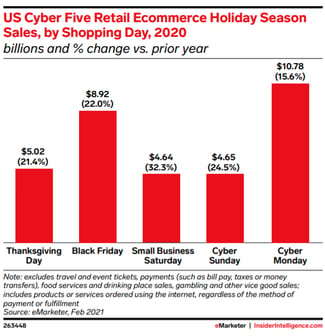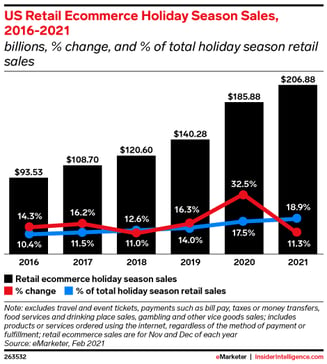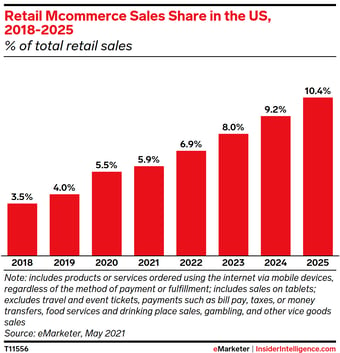With consumers shopping online in greater numbers than ever before, it’s not surprising that this year’s holiday shopping season is set to break all previous records. A recent report from eMarketer estimates that the online segment for 2021 holiday retail sales in the United States could account for 18.9% of the total, an increase of 1.4% over last year’s 17.5% share. Experts predict the bulk of those sales will be generated during the ‘Cyber Five’ period, the five days that start on Thanksgiving and end on Cyber Monday.
Cyber Five Retail Sales, By Shopping Day

Overall, US holiday retail sales revenues are predicted to rise 2.7% to over $1.093 trillion, with $206.88 billion coming directly from e-commerce sales.
US Retail E-Commerce Holiday Season Sales

Retailers with a mobile app presence are also expected to benefit from this surge in online shopping, as consumers who turned to mobile marketplaces during the pandemic continue to utilize these apps to make their purchases. US retail m-commerce last year made up 5.5% of total retail sales and is expected to reach 5.9% by the end of this year. The current trajectory of these numbers indicates that annual sales should be nearly double between now and 2025.
Retail M-Commerce Sales Shares in the US

Overall, m-commerce sales grew over 41% in 2020 and are expected to grow an additional 15.2% in 2021 to $359 billion.
A shortened holiday season may be partially to blame for the coming rise in online purchases. The holiday period, which normally begins in late November or early December, covered a five-week period last year. This year the season length is just four weeks, meaning consumers will have less time to get their shopping done for the holiday season and may turn to online shopping. In addition, with several major retailers planning on keeping their brick and mortar doors shut over the Thanksgiving holiday, the number of consumers going online to scoop up promotional deals will be higher than ever before.
While this is great news for brands, it’s also a reason for brands to be more vigilant than ever when it comes to online brand protection. With consumers looking for convenient ways to shop, brands need to be aware of how their trusted names and intellectual property are being used online and by whom. Even the most mature and robust brand protection strategy will benefit from a pre-holiday audit.
For example, does your brand protection strategy include a mobile apps component? With tech-savvy bad actors quickly adapting to consumers’ embracing m-commerce, it’s critical for brands to incorporate a mobile element into their overall brand protection strategy.
Another major risk vector to evaluate when conducting your audit is to look for sophisticated brand abuse networks targeting your brand. Savvy criminals are setting up complex systemic brand abuse networks that take full advantage of modern marketing techniques, using multiple consumer touchpoints to obfuscate their traces while luring unsuspecting shoppers to fakes and fraud.
To beat this new breed of bad actors, you need modern brand protection solutions that allow you to identify the most egregious offenders and focus your enforcement efforts for maximum impact.
As one of your first steps in your pre-holiday brand protection audit, why not review your enforcement strategy for mobile apps? We’ve published an informative guide that you can download here.